Local News
Simkin Centre receives $725,000 gift from mysterious donor
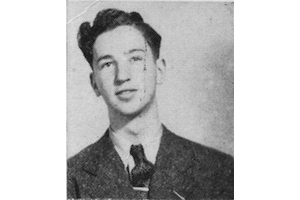
By BERNIE BELLAN
(Posted Oct. 29, updated Oct. 30, Oct.31)
On Oct. 21 we received an email from the Simkin Centre informing us that the centre had received a gift of $725,000 from someone about whom they know almost nothing.
This story has now been amended to reflect crucial information that we have obtained about the individual who was responsible for that sizeable donation. If you want to skip to that new information scroll down to the end of this article. If you want to read how the story unfolded – keep reading.
Here is what the email received on Oct. 21 said:
“The Saul and Claribel Simkin Centre PCH Inc. Board of Directors and The Saul and Claribel Simkin Centre Foundation Board of Directors are pleased to share with you the announcement of an unexpected bequest to the Sharon Home in the amount of $725,937 CDN from the Estate of Myer and Corrine Geller of San Diego, California.
“These funds come to the Centre at an opportune time as we are faced with aging infrastructure and equipment, rising costs with freezes or cuts to government funding and ongoing covid related costs that remain unfunded at this time. A portion of these funds (30%) will be used for the immediate needs of the Centre, including support of our fight against Covid-19. The remainder (70%) of the funds will be allocated to the Jewish Foundation of Manitoba to create our new Building Reserve Fund. This fund will help to ensure our ability to maintain our building and equipment on a long term basis. The Simkin Centre is a world class facility and we want to do our best to keep it that way.
“All we know about the Gellers is they had no children and Myer was a 1943 graduate of St. John’s High School (Winnipeg). Further, Mr. Geller went to MIT, became a physicist and was granted several patents.
“We have been unable to determine why we were the recipient of this bequest. We hope sharing this good news with the community may give us some insight into the mystery. We hope that the Gellers’ generosity will inspire others to consider the Simkin Centre in their estate planning.”
Upon receipt of this tantalizing news, we began to investigate who Myer and Corrine Geller were and the possible reason that they had decided to leave such a substantial amount of money to the Sharon Home.
Beyond the information that was divulged in the Simkin Centre press release we were able to determine some further information about the Gellers. We were aided in this process by Don Aronovitch, who is Chair of the Simkin Foundation, and by Don Harrison, publisher and editor of the San Diego Jewish World.
Myer Geller was born in Winnipeg in 1926. Although we are not certain who his parents were, a search of various websites, including Ancestry.ca, has led us to believe that his father’s name was Max Geller. There were several Max Gellers who lived in Winnipeg in the early part of the 20th century. Unfortunately, none of the archival material that we searched led to a definite conclusion who Myer Geller’s parents were. We also contacted Rena Boroditsky of the Chesed shel Emes to see whether the Chesed’s records give the names of next of kin of deceased, but they don’t. We also spoke with Shelly Sklover, funeral director of Etz Chayim Congregation, to see whether their records give the names of next of kin of deceased. (Of the many Gellers who are buried in Winnipeg cemeteries, 49 out of 51 are buried in cemeteries now under Etz Chayim’s management.) Unfortunately that information is also not contained within the Etz Chayim’s records.
We also searched the archives of our own newspaper and were only able to find one reference to Myer Geller – that he had a bar mitzvah in 1939. A search of the Jewish Heritage Centre’s archives also led nowhere, but unfortunately their archives do not give very precise results.
An email from Don Aronovitch, however, shed some more light as to when the Simkin Centre first became aware that a substantial donation was about to come their way:
“In early October 2019, Laurie (Cerqueti, CEO of the Simkin Centre) was notified we were the 11% Beneficiary of the Myer & Corinne Geller estate in San Diego. While fabulous news, it was so much ‘out of the blue, that we wondered if it was legitimate. We were sent a copy of the Will and gradually, the prospect of this bequest being real came into focus. After a long quiet period, as the estate was being settled, a cheque for $550,000 USD arrived in August payable to the Saul & Claribel Simkin Centre Foundation. After the standard waiting period to see if the cheque cleared the banking system, our bank gave us a ‘thumb’s up’ and it became the focus of the Simkin Centre’s planning process.
“Our efforts to determine ‘who these people were’ & ‘why us’ drew a blank. We determined that Myer graduated from St. John’s High School the same year as Gordon Pullan and that Buddy Brownstone was editor of St. John’s Newsletter. However, neither Gordon nor Buddy had recollection of a Myer Geller. Similarly, we were unable to determine Corinne Geller’s maiden name.”
In addition to the information contained in the Simkin Centre email that Myer Geller graduated from St John’s Tech in 1943, we were able to learn that he moved to the United States in 1949, became an American citizen in 1950, and attended MIT from 1951-55. A search of University of Manitoba records did not disclose that Mr. Geller ever attended that university, so it’s a mystery where else he might have gone to school following his graduation from St. John’s.
Myer Geller married Corrine Taper (although her name is spelled Corrin on their marriage record) in 1954 in New York state. At various times the Gellers lived in New York, Pennsylvania, and California.
The Gellers moved to San Diego in 1988, which is where they lived until their deaths – Myer Geller in 2018 and Corrine Geller in 2019.We managed to locate a close friend of the Gellers, someone by the name of Mikahil Melsitov. Mr. Melsitov did not know whether Myer Geller had any living relatives, although he did think that he had a brother. We attempted to contact anyone by the name Geller in Winnipeg to learn whether any of them knew Myer Geller, but our efforts proved fruitless.
During the course of our conversation with Mikhail Melsitov, he also disclosed that his wife, Oxana, was a trustee of the Geller Trust, which donated the $725,000 Cdn. to the Sharon Home. Although Mr. Melsitov was quite friendly during our 20-minute conversation and was willing to give us his wife’s cell number, all attempts to contact her proved futile. Further attempts to contact Mr. Melsitov also led nowhere. (Why did both Melsitovs refuse to respond to our repeated attempts to contact them, we wonder, especially when Mr. Melsitov had been so friendly during our only phone call?) Something that Mr. Melsitov did say that aroused our interest though was that representatives of the Geller Trust had difficulty making contact with the Simkin Centre in August 2019, following Mrs. Geller’s death. Presumably that was because they were trying to contact the Sharon Home. After all, Myer Geller had left Winnipeg 70 years earlier and would he even have been aware that the Sharon Home was now the Simkin Centre?
We also attempted to contact various lawyers who were associated with Myer Geller, none of whom responded to our phone messages or emails. We did discover that the Geller home was sold by their estate for $1.25 million in April of this year. The home was not overly large – only two bedrooms and two bathrooms. (By the way, the taxes were only $2,700 on their home. That gives you an idea how high our city taxes are in Winnipeg compared to other cities – as if you needed to be reminded.)
But if the donation to the Simkin Centre constituted only 11% of the total amount left to all beneficiaries of the Geller Trust, the Geller Trust would have been worth close to $7 million Canadian.
How did Myer Geller amass such a large fortune?
From what we were able to determine he was an inventor of extraordinary ability. Myer Geller’s name is associated with 15 different patents. For at least a certain period of his life he worked for a branch of the US Navy called the Naval Operations Support Centre. We attempted to contact a representative of the NOSC to find out if there was anything we could be told about Mr. Geller, but were unsuccessful.
So, the question that tantalizes is: Why would someone who had left Winnipeg 70 years ago want to leave such a substantial donation to the Jewish nursing home (which is now referred to as a personal care home)?
We asked Don Aronovitch whether the Simkin Centre had searched its records to try to find the name of someone who might have been a relative of Myer Geller?
Don responded: “None that we could find. We had very few leads and they all led to a dead end.”
We commented to Don: “It just seems so strange that 70 years after having left Winnipeg he leaves so much money to the Winnipeg Jewish nursing home – and nobody knows anything about him.”
Don Aronovitch agreed: “Very strange but there is a story there. We just do not yet know what it is.”
If anyone reading this is able to shed some light on Myer Geller please contact this newspaper. We’d love to be able to report at some future date that we solved this mystery.
Post script: Since this story first appeared in the Oct. 28 issue of The Jewish Post & News we have received some very intresting responses from a number of different readers.
One reader said they actually had a copy of the 1943 St. John’s yearbook with Myer Geller’s picture in it. We’re reproduced that photo on this site. The caption accompanying the photo says: “Myer Geller – A good man to have around when scholastics come to the fore, Myer is the fellow who has made the Reserve Army what it is today.”
Then we received an email from another reader who has been fascinated by the story and who contacted a friend who is an ardent genealogist. Their friend did some further digging beyond what I had come up with and sent the following information: “Myer died on 12/30/16. He and Corinne, who was born 2/12/26, bought their house at 1622 Plum St. in San Diego in 1993. He got his degree from MIT in 1955 and in 1960 or 1961 moved from a job at Hughes Products to be a senior scientist at the Solid State Division of Electro-Optical Systems in Pasadena, CA. He was a registered Democrat.”
Updated Oct. 30: Reader Ed Feuer came up with even further information about Myer Geller. In a post to our Facebook page Ed wrote that he had found a reference to Myer Geller in the July 5 archives of the Winnipeg Free Press, in a notice headed “City man receives Massachussetts degree” The body of the notice says: “Myer Geller, son of Mr. and Mrs. M. Geller, 284 Bannerman Avenue, has received his doctor of physics degree from the Massachussetts Institute of Technology, Boston. Mr. Geller attended St John’s technical high school and the University of Manitoba. He received his master’s degree in physics at the University of Minnesota.”
There are only two Gellers in Winnipeg whose first names begin with M who could have been Myer Geller’s father – and both had the first name Max. One Max Geller died in 1956, and one in 1966. Unfortunately neither one appears in the Free Press obituary archives. But – we’ve determined that the Max Geller who died in 1956 was married to Dora, who did live in the Sharon Home. But Dora’s obituary makes no reference to a Myer Geller.
The other Max Geller died in 1966. His wife’s name was Sarah (née Feldman). We haven’t been able to find an obituary for either one. The question is: Did either Max or Sarah Geller live in the Sharon Home prior to their death?
Update Oct. 31: We received further information from reader Ed Feuer, who found Max Geller’s obituary notice in the Winnipeg Tribune archives.
Ed confirmed that Myer Geller’s parents were Max and Sarah Geller. He also disclosed that Myer Geller had two sisters: Frances – who was married to an Edward Jordan in Toronto; and Rose – who was married to Louis Lieberman, also of Toronto.
We will attempt to obtain any information about either sister. But, if anyone reading this does have some information that woud be useful, please contact me at jewishp@mymts.net or call me at 1-204-694-3332.
Local News
Thank you to the community from the Chesed Shel Emes
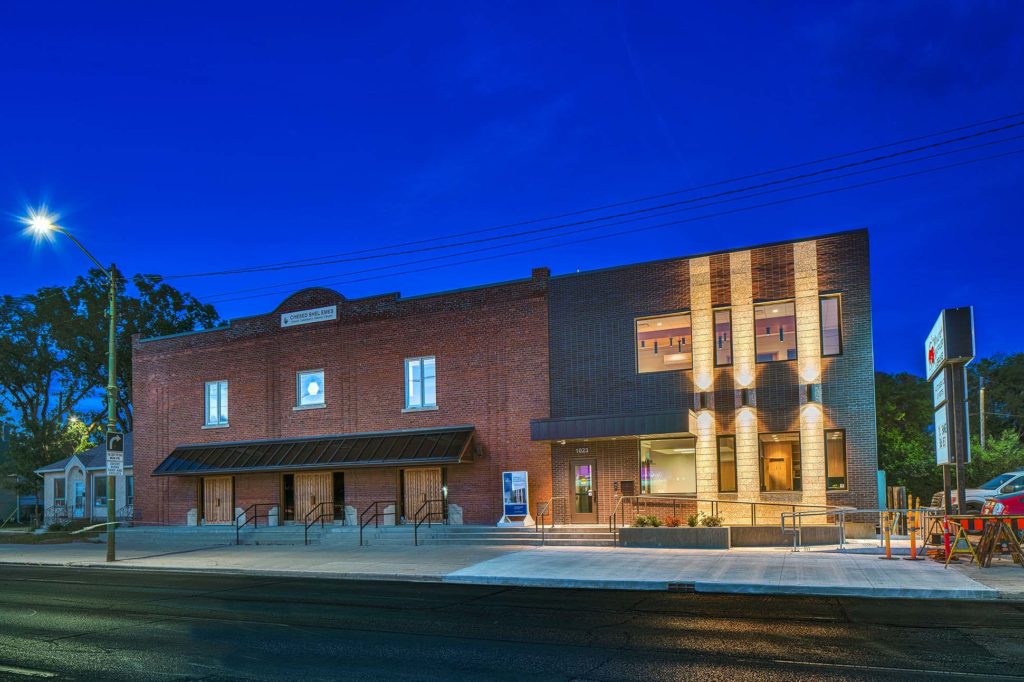
We’re delighted to share a major milestone in our Capital Campaign, “Building on our Tradition.” Launched in November 2018, this campaign aimed to replace our outdated facility with a modern space tailored to our unique needs. Our new building is designed with ritual at its core, featuring ample preparation space, Shomer space, and storage, creating a warm and welcoming environment for our community during times of need.
We’re grateful to the nearly 1,000 generous donors who contributed over $4 million towards our new facility. A $750,000 mortgage will be retired in November 2025, completing this monumental project in just seven years.
We’re also thrilled to announce that our Chesed Shel Emes Endowment Fund has grown tenfold, from $15,000 to $150,000, thanks to you, the Jewish Foundation of Manitoba’s FundMatch program, and Million Dollar Match initiative in 2024. Our fund helps ensure that everyone can have a dignified Jewish funeral regardless of financial need.
As we look to the future, our goal remains to ensure the Chevra Kadisha continues to serve our community for generations to come. Our focus now shifts to replenishing our savings account and growing our JFM Endowment fund.
We’re deeply grateful for your support over the past several years.
It’s our privilege to serve our community with care and compassion.
With sincere appreciation,
Campaign cabinet: Hillel Kravetsky, Gerry Pritchard, Stuart Pudavick,
Jack Solomon, and Rena Boroditsky
Murray S. Greenfield, President
Local News
Winnipeg Beach Synagogue about to celebrate 75th anniversary
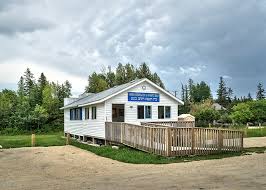
By BERNIE BELLAN (July 13) In 1950 a group of cottage owners at Winnipeg Beach took it upon themselves to relocate a one-room schoolhouse that was in the Beausejour area to Winnipeg Beach where it became the beach synagogue at the corner of Hazel and Grove.
There it stayed until 1998 when it was moved to its current location at Camp Massad.
On August 2nd members of the synagogue will be holding a 75th anniversary celebration.
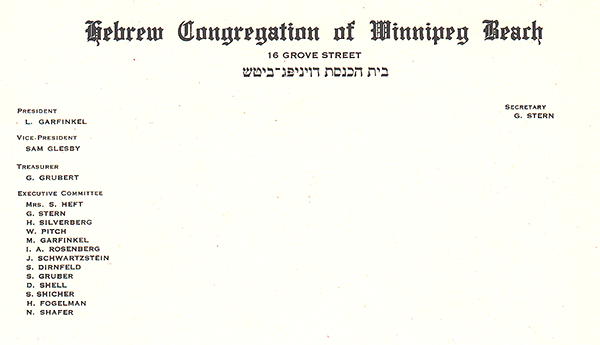
As part of the celebration anyone who is a descendant or relative of any of the original members of the first executive committee (as seen in the photo here) is invited to attend the synagogue that morning.
If you are a relative please contact Abe Borzykowski at wpgbeachshule@shaw.ca or aborzykowski@shaw.ca to let Abe know you might be attending or for more information about the 75th anniversary celebration.
We will soon be publishing a story about the history of the beach synagogue, which is something I’ve been writing about for over 25 years.
Local News
Vickar Family cuts ribbon on new Tova Vickar and Family Childcare Centre
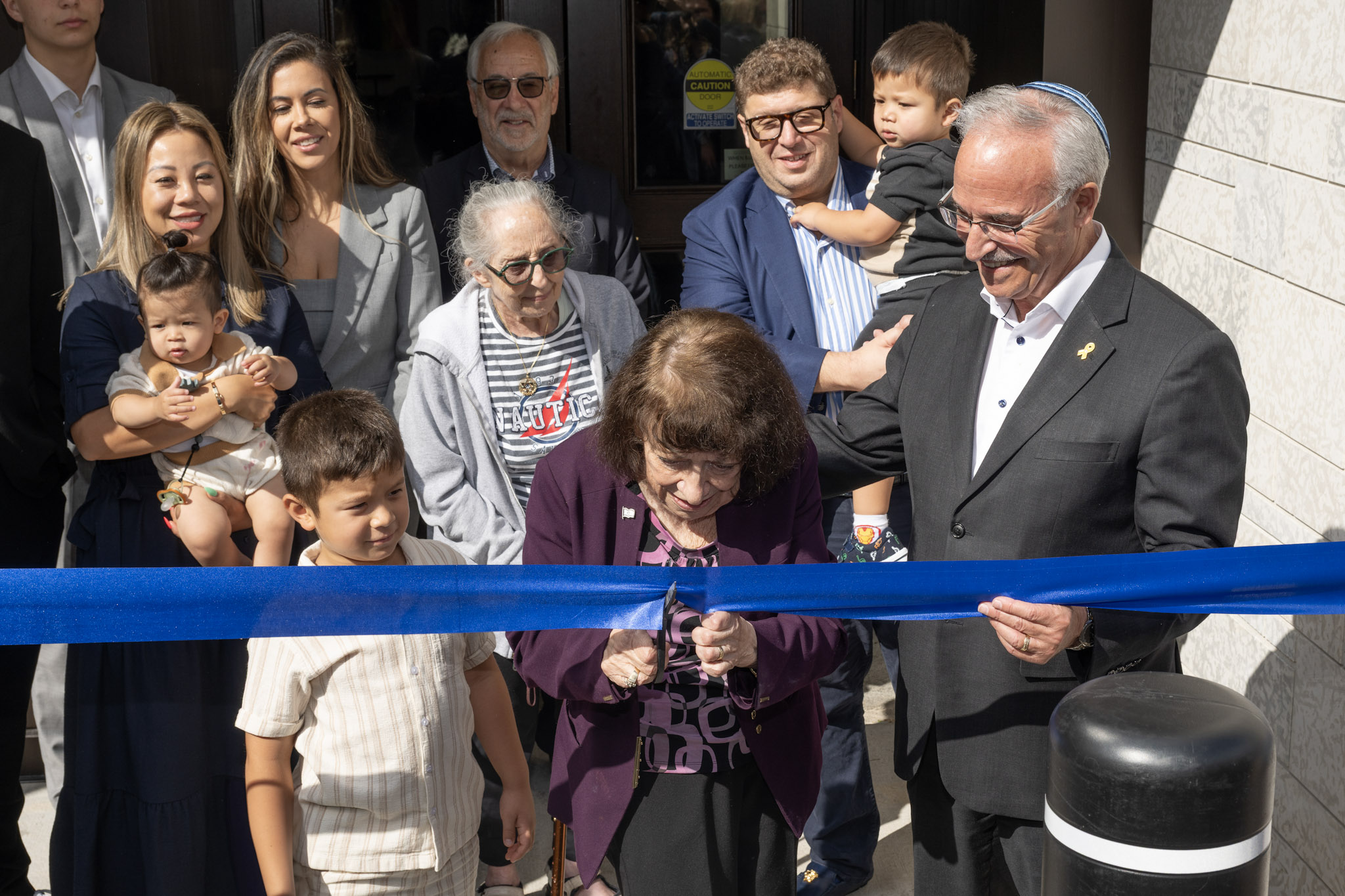
By MYRON LOVE In the words of Larry Vickar, the Shaarey Zedek’s successful Dor V’ Dor Campaign “is not only a renewal of the synagogue but truly a renewal movement of Jewish life in our community.”An integral part of that renewal movement was the creation of a daycare centre within the expanded synagogue. On Monday, June 23, Larry and Tova Vickar cut the ribbon, thereby officially opening the Tova Vickar and Family Childcare Centre in the presence of 100 of their family members, friends and other supporters of the project.
The short program preceding the morning ribbon-cutting began with a continental breakfast followed by a welcome by both Fanny Levy, Shaarey Zedek’s Board President, and Executive Director Dr. Rena Secter Elbaze. In Elbaze’s remarks, she noted that Larry and Tova wanted their family (including son Stephen and family, who flew in from Florida) and friends at the event to celebrate the opening of the Tova Vickar and Family Childcare Centre, “not because of the accolades, but because, as Larry put it, he hopes that their investment in the congregation will inspire others to do the same.”
“When Larry and I spoke about what this gift meant to him and the message he wanted people to take away,” she continued, “I couldn’t help but connect it to the teachings of Reb Zalman Schachter-Shalomi whose book – Age-ing to Sage-ing – changes the whole way we look at the concept of ageing and basing it on our ancestral teachings.”
She explained that his concept of “Sage-ing” is based on three key ideas – Discover your meaning and purpose; accept our mortality and think about the legacy you want to leave.
“Larry spoke about these exact concepts when we met,” she said.
Elbaze also noted the presence of Shaarey Zedek’s newly-arrived senior Rabbi Carnie Rose, former Rabbi Alan Green, and area MLAs Mike Moroz and Carla Compton.
Larry Vickar expressed his great appreciation for all those in attendance. “Tova and I are deeply moved to stand here with you today for this important milestone in our community”, he said. “We are grateful to be surrounded by all of you, the people we care about, our family and friends… you who have touched our lives and played some part in our journey.”
